How RIT has become a Leader in Sustainability
A. Sue Weisler
Research labs, student work areas, classrooms and conference rooms in Sustainability Institute Hall all open onto a light-filled, four-story galleria space.
Nabil Nasr had a vision: Create a world-class research and education hub for sustainability. Establish the first doctoral program in sustainability. Position RIT as a global leader in the field of sustainable design and product development. And open RIT’s first living lab, a building filled with cutting-edge technology that serves as a classroom and inspires students.
The director of RIT’s Center for Integrated Manufacturing Studies told all of this to the Board of Trustees in November 2004 as part of a discussion on big ideas to help the university grow. At that time, few people were talking about what happens to products after they are done being used.
“I can’t imagine what the Board of Trustees was thinking,” says Nasr. “This crazy guy wants to build another Ph.D. program. He wants to build a sustainable building.”
Soon Nasr had secured initial funding for a study from the Henry Luce Foundation, which resulted in more funding, including a naming gift from B. Thomas Golisano, and RIT’s Golisano Institute for Sustainability (GIS) was created. The educational programs, research and partnerships with companies followed, and in 2010, the U.S. Department of Commerce’s National Institute of Standards and Technology granted the program $13.1 million for the construction of a green facility.
In April, GIS will dedicate its new $40-million building, which is indeed a living lab. The building even looks similar to the one Nasr, now assistant provost and the director of GIS, used in his 2004 PowerPoint presentation to the trustees. And it houses a program that has become one of the best in the nation.
In the short term, the facility is expected to create 75 new jobs at RIT and 1,000 jobs offsite at regional manufacturing firms. Longer term, Nasr projects significant additional job growth related to GIS both on campus and throughout the upstate New York region.
“We see RIT as a leader in the country in the sustainability movement, if not No. 1 in industrial leadership in sustainability,” says Owen Foster, senior vice president of marketing and sustainability at Rochester Midland Corp., a manufacturer of specialty chemicals and a longtime partner with GIS. “In my travels and networking, I see other universities involved in sustainability but when I look at where their interface is with industry, there isn’t a lot. There is nothing like what I get at RIT.”
Nasr’s vision, though, has always included an element bigger than RIT. The global population is increasing by almost 75 million people a year and is predicted to reach 8 billion by 2025. There are not enough resources to supply the world’s rapidly growing appetite for new and better products. Something has to change and Nasr plans to be part of the transition.
A different approach
Nasr wasn’t always concerned about the lifecycle of products. The Rutgers-trained industrial and manufacturing engineer joined RIT’s College of Engineering in 1989 as an assistant professor teaching topics such as robotics and manufacturing processes.
Nasr was attracted to RIT because of the applied-research nature of the university, its resources and he could continue his consulting work designing manufacturing facilities one day a week. One project was with Xerox, where he stumbled upon a new concept.
“They called it remanufacturing of equipment,” he says. “We were never taught anything like that at engineering schools.”
At the same time, he was working with Kodak to design a new facility for its ortho-clinical diagnostics division and that company, too, was talking about what happens to products when they are done being used.
To learn more, Nasr put on his blue jeans and worked on the assembly line with Kodak employees during quarter break, disassembling equipment, inspecting the parts and cleaning and salvaging the materials.
“No one was thinking about what is going to happen at the end of life so we can reclaim that material. You want to get a microphone and tell everyone in the design and engineering community, we are making a lot of problems here. We should pay attention to these issues.”
In the early 1990s, Nasr found himself with such a microphone. He wrote a paper he called “Turning Trash Into Cash” that was picked up by The Associated Press. Soon Nasr’s name appeared in hundreds of newspapers.
The stories caught the attention of people in the then-small remanufacturing industry, and Nasr was named head of the Remanufacturing Industries Council. He visited remanufacturing companies, learned as much as he could about the process of rebuilding equipment instead of replacing it and built strong ties to industry.
He founded the National Center for Remanufacturing and Resource Recovery, and in 1997, Nasr’s operation was moved from engineering to the newly opened Center for Integrated Manufacturing Studies, known on campus as CIMS.
CIMS focused on remanufacturing, lifecycle engineering and alternative energy development. The center contracted with companies and government agencies to solve manufacturing problems.
Al Simone, RIT president from 1992 to 2007, was quickly won over by Nasr and provided the initial funding for Nasr’s remanufacturing and resource recovery program.
Simone tells the story of a meeting he and Nasr had with a senior U.S. senator in Washington, D.C. The senator brought in his expert to quiz Nasr on his knowledge of remanufacturing. The expert realized that Nasr not only knew the answers to his questions but also had new information to share. By the end of the meeting, Nasr was mentoring the expert.
“The rare person is one that can have the vision and then have the capability of actually executing that vision. Nabil is one of those people,” Simone says. “To execute you have to work hard, be dedicated, focused and committed. But there is one key attribute Nabil also has, which is his sincerity. His intelligence and knowledge of the subject matter comes through. He is able to get people to support his ideas and support his execution.”
Nasr became director of CIMS in 2002 and continued to grow the operation. CIMS contracted with the U.S. Navy and Marine Corps to apply its knowledge in remanufacturing to large equipment, which resulted in cost savings to the military by extending the lives of aging vehicles, ships and planes. Researchers also developed a system to monitor the performance of military vehicles. (That system was later expanded to the commercial freight industry and resulted in the spin-off company Vnomics, which recently graduated from RIT’s incubator Venture Creations.) They studied ways to use fuel cells and alternative fuels in buses, trucks and other public transportation. Engineers and technicians began analyzing components used in making toner cartridges to help manufacturers reduce waste.
And they worked with companies—big and small— to reduce their environmental footprint by changing their design methodology and developing an innovative product that was greener or that would last longer. That process helped to create more than 1,500 jobs and retain more than 1,900 additional positions at manufacturing companies worldwide.
All of this work fell under the umbrella of sustainability. But Nasr wanted more.
“We want to have impact,” Nasr says. “Education was the only way to spread the word. This was my dream.”
Creating an institute
Paul Stiebitz was four months into retirement in 2006 when he got a call from his former colleague. The two met for lunch and Nasr told the retired professor, who taught industrial engineering at RIT for 22 years, of his plans to start a sustainability institute. Nasr invited Stiebitz to work with him.
“I started the next morning at 8 o’clock,” Stiebitz says. “What better thing to do in the retirement period than to create education and research that will help out on some really tough problems that the world is facing. So I came back.”
RIT had already secured a $465,000 grant from the Henry Luce Foundation to create one of the first multidisciplinary Ph.D. programs in sustainability.
Stiebitz began working on a curriculum concept and formed a curriculum committee to help move the concept through the approval process. That would be challenging because the programs were multidisciplinary and involved faculty and resources from different colleges.
Nasr, Simone and Bill Destler, who had just joined RIT as president, pitched the idea of a sustainability institute to Golisano, founder and chairman of Paychex Inc. and an RIT trustee. Golisano was familiar with sustainability through his work with the Clinton Global Initiative, which was formed by former President Bill Clinton in 2005.
“He challenged us,” Nasr says about Golisano. “He is brilliant with numbers. He said, ‘I want to see value to the community. I want to see it by design and not by accident.’ ”
In September 2007, Golisano donated $10 million and the Golisano Institute for Sustainability was created. “It is imperative that we accelerate strategies to promote a sustainable society and ensure future generations the opportunity to address their own needs,” Golisano said at the time.
With the help of Destler, who shares Nasr’s passion for sustainability, others got on board with support, including Xerox Corp., Caterpillar Inc., Eastman Kodak Co., Staples, Rochester Midland Corp., the Carlson Charitable Fund and the Shumway Foundation.
Each year marked additional growth.
In 2008, RIT was named host of the New York State Pollution Prevention Institute, which works to make the state more sustainable for workers, the public, the environment and the economy.
The pollution prevention institute is a partnership with three other universities and 10 regional development centers.
Other divisions in GIS continued to focus on remanufacturing resource and recovery, sustainable production and sustainable transportation issues.
That same year, the first four Ph.D. students in sustainability were admitted to the program.
All that was left for Nasr was the construction of a building, where it could all reside. But that building had to inspire people—as one of the greenest in the world and as a living lab for students to study.
If you build it
Among the first to help with the final goal was the Rochester region’s state legislative delegation, which secured $10 million for the project in the 2008-2009 state budget.
“The building will be of tremendous value to RIT,” says state Sen. Joseph Robach. “But it will go above and beyond that by creating spinoff jobs, technology and products not only created here but developed here.”
Two years later, RIT was awarded $13.1 million from the U.S. Department of Commerce’s National Institute of Standards and Technology—the largest award in the NIST construction program that year.
In December, New York Gov. Andrew Cuomo announced that GIS would receive $5 million as part of the Finger Lakes region’s funding award through the governor’s Regional Economic Development Council process. The funds will be used to equip the institute’s unique suite of labs and testbeds.
Stella Fiotes, former chief facilities management officer for NIST, says of particular interest to NIST was that the new facility will pull together a variety of sustainability researchers focusing on energy, transportation, sustainable materials and systems for printing and imaging, products and production systems and building systems.
“This proposal had the most comprehensive and broad focus on researching sustainability issues out of all 92 proposals submitted,” Fiotes says.
The research generated in the building will be critical, as sustainability becomes the next major movement in industry. GIS has already branched out into the eco-IT area, or reducing energy consumption of electronic devices. The new building’s computer server room will allow researchers to further explore reduction possibilities, which could result in huge cost savings for companies. In addition, researchers in the new Staples Sustainable Innovation Lab in the building will figure out ways to better design and manufacture green office products and services.
Foster, of Rochester Midland Corp., says sustainability issues today are on par with the environmental movement in the 1960s and 1970s and quality concerns in the 1980s and 1990s.
“Bids, government requirements, customer requirements are demanding all of the documentation of our position in sustainability. What do we have for a sustainability report? What are our metrics? What have we done to lower our carbon footprint? All of these questions didn’t exist in 2007,” Foster says about the year he first attended a conference at RIT on sustainability.
One of the reasons Rochester Midland has stayed ahead of sustainability is because of its work with RIT and the company’s commitment to the issue, he says. Along with producing products in a more sustainable way, the company has defined its sustainability mission and created a sustainability certification program.
The company has even organized a special interest group made up of representatives from 40 area companies to talk about sustainability issues.
This spinoff effect is what matters to Nasr. For the world to use less energy and create less waste, it is going to take everyone working together for generations—from industry to educators. “There’s a lot to be done,” Nasr says. “We are scratching the surface.”
Spreading the word
More than 50 students are now enrolled in GIS graduate programs, which by 2011 along with the Ph.D. in sustainability included both the master’s program in sustainable systems, and the Master of Architecture degree program, which has an emphasis on sustainability.
Niles Barnes, senior programs coordinator for the Association for the Advancement of Sustainability in Higher Education, says his organization calculates there are only about 145 sustainability degree programs at the more than 3,500 universities in the United States.
“Offering a degree in sustainability is still very unique, especially at the Ph.D. level,” he says.
When the programs are fully populated, the number of students will swell to more than 130. This May, four Ph.D. students and four master’s students in sustainable systems are on track to graduate.
They will then take their passion out into the world and work on their own pockets of sustainability.
Congresswoman Louise Slaughter says she believes one of them could be the next Chester Carlson or George Eastman.
“Thanks to centers like GIS that bring the world’s top academics, researchers and students to Rochester, they will have the resources and expertise to realize their dream of creating the next big technological advancement,” she says.
Nasr and the dozen faculty members of GIS continue to spread the message globally. RIT is working with the Clinton Global Initiative to create educational materials and guidebooks, curriculum advisory groups, faculty exchange programs and a mentorship program with the Dominican Republic, Egypt, Indonesia, Malaysia and Peru in an effort to share the model of sustainability.
The federal government also tapped Nasr to help develop international sustainability standards. He helped the Organisation for Economic Cooperation and Development create the sustainable manufacturing toolkit, which will give companies metrics to use to measure their environmental performance.
Closer to home, Nasr and his team hope to use the new building to teach the Rochester community about sustainability. The educational efforts are all about preparing students for the future and playing a role in ensuring there is a future for this generation and the next.
State Assembly Majority Leader Joseph Morelle, who has worked with Nasr since the early days of remanufacturing, says he isn’t sure people fully appreciate how unique it is to have a center like this in Rochester. Soon they will, and the Golisano Institute for Sustainability will cement Nasr’s legacy in Rochester and around the world.
“My goal now in my career is that when I’m retired one day—if I ever retire—and think back about what we were able to do, I want to have contributed to society and feel good about it,” Nasr says, slowly smiling. “That is really my biggest goal. It is not money. It’s not recognition. It’s making sure that when we had a chance, we did the right thing.”
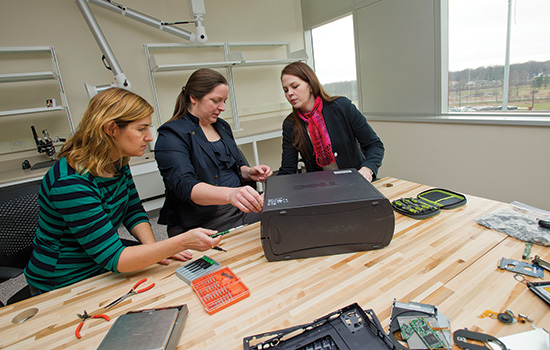 From left, Ph.D. candidate Erinn Ryen; Barbara Kasulaitis, a first-year Ph.D. student; and assistant professor Callie Babbitt disassemble computers to identify high environmental impact materials and test strategies for designing electronics that can be more easily reused and recycled. A. Sue Weisler
From left, Ph.D. candidate Erinn Ryen; Barbara Kasulaitis, a first-year Ph.D. student; and assistant professor Callie Babbitt disassemble computers to identify high environmental impact materials and test strategies for designing electronics that can be more easily reused and recycled. A. Sue Weisler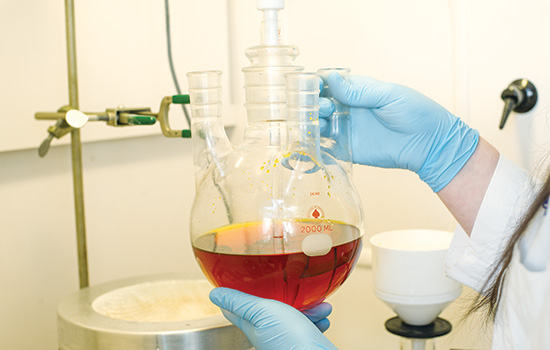 This organic acid solution is used as a leaching agent to recover precious and scarce metals from a lithium-ion battery waste stream. A. Sue Weisler
This organic acid solution is used as a leaching agent to recover precious and scarce metals from a lithium-ion battery waste stream. A. Sue Weisler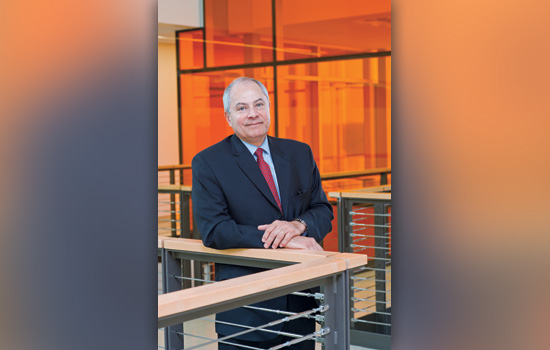 Nabil Nasr, assistant provost and director of Golisano Institute for Sustainabilty, stands in the recently completed Sustainability Institute Hall. The building is one of the greenest in the world and acts as a living lab for students to study. A. Sue Weisler
Nabil Nasr, assistant provost and director of Golisano Institute for Sustainabilty, stands in the recently completed Sustainability Institute Hall. The building is one of the greenest in the world and acts as a living lab for students to study. A. Sue Weisler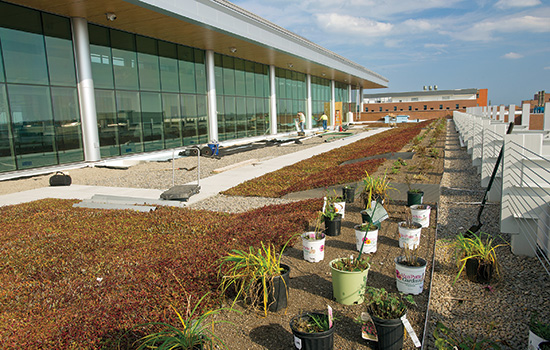 An open-air terrace on the third floor of Sustainability Institute Hall features large areas of sedum and plantings that are part of Rochester’s Seneca Park Zoo Butterfly Beltway project. A. Sue Weisler
An open-air terrace on the third floor of Sustainability Institute Hall features large areas of sedum and plantings that are part of Rochester’s Seneca Park Zoo Butterfly Beltway project. A. Sue Weisler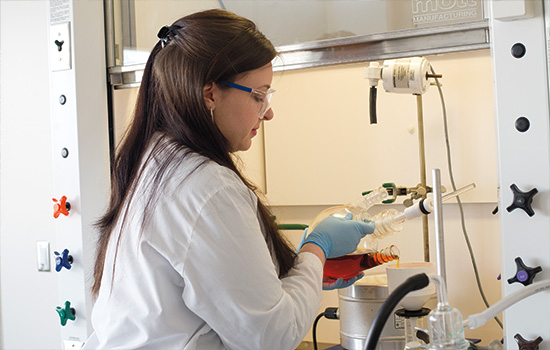 Chelsea Bailey, a third-year Ph.D. candidate in sustainability, is researching greener ways to recycle lithium-ion batteries discarded after use in electric vehicles and consumer electronics. A. Sue Weisler
Chelsea Bailey, a third-year Ph.D. candidate in sustainability, is researching greener ways to recycle lithium-ion batteries discarded after use in electric vehicles and consumer electronics. A. Sue Weisler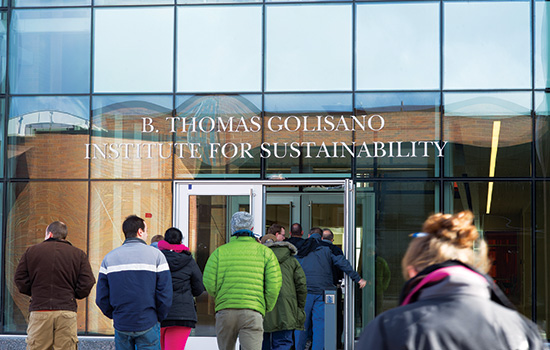 Nabil Nasr’s dream was to open RIT’s first living lab, a building filled with cutting-edge technology that serves as a classroom and inspires students. The dedication and ribbon cutting for Sustainability Institute Hall is scheduled for April 12. A. Sue Weisler
Nabil Nasr’s dream was to open RIT’s first living lab, a building filled with cutting-edge technology that serves as a classroom and inspires students. The dedication and ribbon cutting for Sustainability Institute Hall is scheduled for April 12. A. Sue Weisler





